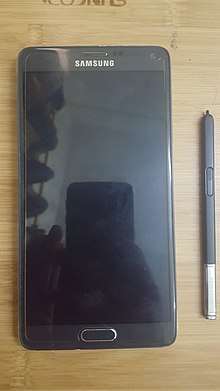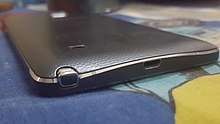Samsung Galaxy Note 4
The Samsung Galaxy Note 4 is an Android phablet smartphone developed and produced by Samsung Electronics. The Galaxy Note 4 was unveiled during a Samsung press conference at IFA Berlin on 3 September 2014 and was released globally in October 2014.[1] It is the successor to the Samsung Galaxy Note 3. Its subsequent model, the Samsung Galaxy Note 5, was unveiled on 13 August 2015.
 | |
 Samsung Galaxy Note 4 in White | |
| Brand | Samsung Galaxy |
|---|---|
| Manufacturer | Samsung Electronics |
| Slogan | Do You Note? |
| Series | Galaxy Note |
| Model |
|
| Availability by region |
|
| Predecessor | Samsung Galaxy Note 3 |
| Successor | Samsung Galaxy Note 5 |
| Related | |
| Type | Phablet |
| Form factor | Slate |
| Dimensions |
|
| Mass | 176 g (6.2 oz) |
| Operating system |
|
| System on chip | |
| CPU |
|
| GPU |
|
| Memory | 3 GB LPDDR3 |
| Storage |
|
| Removable storage | microSDXC up to 256 GB |
| Battery |
|
| Data inputs | List
|
| Display | 5.7 inch (145 mm) Quad HD Super AMOLED (16:9 aspect ratio) 2560×1440 pixel resolution, 518 ppi |
| Rear camera | 16 MP, f2.2, 1/2.6 inch sensor, with autofocus, OIS, 2160p at 30fps(limited to 5 mins), 1440p at 30fps, 1080p at 30/60fps, 720p at 30/60 fps, slow motion video recording at 720p at 120fps |
| Front camera | 3.7 MP, f1.9, 1440p/1080p/720p video recording |
| Connectivity | |
| Development status | Released |
| Website | Official website |
Specifications
Hardware


The Samsung Galaxy Note 4 features a 2560×1440 Quad HD (QHD) WQ HD Super AMOLED 5.7-inch display with 2.5D damage-resistant Gorilla Glass 4 and provides a pixel density of 515 ppi (pixels-per-inch). The Note 4 came in two variants, one powered by a 2.7 GHz quad-core Snapdragon 805 chipset with Adreno 420 GPU, the other powered by Samsung's ARMv8-A Exynos 7 Octa SoC with two clusters of four cores; four Cortex-A57 cores at 1.9 GHz, and four Cortex-A53 cores at 1.3 GHz, which is the same processor cluster sold for the Samsung Galaxy Note 3 in markets that mostly use or only have 3G (such as HSUPA and HSPA), and/or '2G', such as unaltered GSM and CDMA networks, similar to how the Galaxy Note 3 is sold. The phone has metal edges with a plastic, faux leather back.
The China model is TD-LTE and TD-SCDMA Plus Network.
Both devices that use 4G, LTE/LTE-A and Hybrid 4G-LTE Networks were only sold in Canada, Australia, the U.S., the United Kingdom (for some carriers), Sweden, Norway, Denmark, and South Korea, which have widespread 4G LTE Markets, or are solely 4G/LTE/LTE-A dependant such as Canada and Denmark, which did not use any 3G or older networks, except for HSUPA (Used as a fall back network should the signal strength be weak due to being underground or in the middle of a building), as well as HSPA+, which is a 3G network, though considered by some to be the Original 4G.[2][3][4] The GPU in charge in the Exynos chipset is the Mali-T760.[5] Both variants came with 3GB of LPDDR3 RAM and 32GB of internal memory.[6] Samsung touted new S-Pen features including tilt and rotation recognition[7] but these features were either not implemented or not supported.[8] The Note 4's back-cover has a strong resemblance to the Note 3, with a faux leather texture (although without the simulated stitching). Note 4 has a new aluminum frame design, bearing resemblance from the Samsung Galaxy Alpha. Criticism has been aimed at the lack of IP67 certification (water and dust resistance), which was present in Samsung's other flagship, the Galaxy S5, released half a year earlier.
The Note 4 also incorporates a user-removable 3,220mAh lithium-ion battery for the global model and a 3,000mAh non-removable lithium battery variant for the model sold in China. The global model is the last Samsung Mobile flagship to be equipped with user-replaceable battery.
The Note 4 features a USB 2.0 charging port instead of USB 3.0 (as was in the Note 3 and S5), in favor of a new feature called Fast Charge, which Samsung claims can charge the phone from 0% to 50% in about 30 minutes and from 0% to 100% in less than 100 minutes. It features some unique sensors such as a UV sensor and heart-rate monitor, oximeter, among other, more common sensors. However, the Note 4 lacks the thermometer and hygrometer sensors which the Galaxy S4 and Galaxy Note 3 fromn2013 were equipped witj.
Like the predecessors, the Note 4 also includes a stylus pen, branded S-Pen incorporated into the design.
The Air View feature is no longer useable with fingers like it was on the S4, Note 3 and S5. However, it is still useable with the stylus.
Software
The Samsung Galaxy Note 4 originally shipped with Google's mobile operating system, Android, specifically KitKat 4.4.4, with its user interface modified with Samsung's custom skin named TouchWiz Nature UX 3.0. The Note 4 contains most of the original Note's software features and functions, but also adds more significant upgrades from the predecessors, such as a new multitasking interface, expanded S-Pen functions, gestures, and refreshed menus and icons.
The device can be updated to Android 5.0.1 Lollipop in many regions, bringing a new, refined UI, and new runtime. This version has been criticized for poor battery life. A further update to 5.1.1 is available, depending on the wireless carrier.
Most Note 4 devices can also be updated to Android 6.0.1 Marshmallow, bringing Android features like Android Doze (a feature introduced in Marshmallow that saves battery life) and greater control over app permissions to the device. The Note 4 TouchWiz UI was also improved featuring new stock app icons and also features new S Pen features (Most from the Galaxy Note 5) like the new Air command and Screen-off memo. However, the UI is still very similar to the previous UI and slightly similar to the S6 UI, but most of the TouchWiz UI resembles the original UI for the Note 4.
Camera

The main (rear-facing) camera is a 16 Megapixel (5322×2988) autofocus camera with 16:9 aspect ratio image sensor (Sony IMX240), featuring Smart OIS (Optical Image Stabilization + software image stabilization), being the first mobile phone of the Samsung Galaxy Note series and the first original variant Samsung flagship phone to feature an opticlaly stabilized rear camera.
It allows 4K video recording at 30 fps and 1080p video recording at 30 fps and 60 fps (Smooth Motion) and also it has 120 fps slow-motion video recording in 720p resolution.
The secondary (front-facing) camera is a 3.7 MP camera with an f1.9 aperture that can record 2560×1440 QHD videos and capture wide-angle pictures.
The Galaxy Note 4's front camera is the first front camera in any mobile phone that is able to record videos at 1440p resolution.
After the LG G3, the Galaxy Note 4 is the second mobile phone to be able to record optically stabilized 2160p (4K) video.
Sales
Samsung Galaxy Note 4 was released around the start of October 2014 and was available in most major markets by the middle of October. The first regions to receive the device were South Korea and China where it gained huge popularity. In the first month only, the Galaxy Note 4 reportedly sold 4.5 million units, which is a little less than its predecessor, the Galaxy Note 3, which was able to report 5 million sales in the first month after release.[9][10] Samsung says that sales of the Note 4 were lower than those of the Note 3 at launch because the Note 4 was initially unavailable in some major international markets due to manufacturing issues, delaying release until early November in markets including the United Kingdom and India.
Plug-in for Samsung Gear VR
Only Snapdragon variants of the Samsung Galaxy Note 4, sold by US and European mobile carriers, may be plugged into the Samsung Gear VR headset, which was created in partnership with Oculus VR.[11]
Reception
The phone was met with critical acclaim. When the Note 4 was released in late 2014, DisplayMate measured the performance of the display and said it was the best performing smartphone display ever tested and raised the bar for display performance.[12] Note 4s were used to film Cai Lan Gong, the world's first feature film shot with a smartphone at 4K resolution.[13]
Successor
The Samsung Galaxy Note 5 (branded and marketed as Samsung Galaxy Note5) is an Android phablet smartphone developed and produced by Samsung Electronics. The Galaxy Note 5, along with the Galaxy S6 Edge+, was unveiled during a Samsung press conference in New York City on 13 August 2015. It is the successor to the Samsung Galaxy Note 4. The phone became available in the U.S. on 21 August 2015.
White background by default
On the Galaxy Note 4 (since Android 4.4.4), and also the S4, Note 3 and S5 (Android 5.0 update), the default theme of the user interface software utilizes white backgrounds with black text instead of vice versa (as previously), which defeats the main benefit of AMOLED displays, which is power saving for darker pixels. Additionally, white backgrounds shorten the lifespan of AMOLED panels significantly and could cause additional eye strain, especially in dark surroundings, even at minimum screen brightness.
See also
References
- Rubin, Ben Fox (September 3, 2014). "Samsung unveils Galaxy Note 4, Note Edge". CNET. Retrieved September 3, 2014.
- TELUS Communications Company. "TELUS - Wireless, TV, Internet and Home Phone service - TELUS.com". telusmobility.ca.
- http://www.Rogerswireless.ca Archived 2007-11-12 at the Wayback Machine
- Rogers uses LTE-A (150 to 200mb/s) in the 10 largest cities in Canada, however can drop down to HSPA+ during low coverage. Also, Wind Mobile uses only the fallback networks of HSPA+ and HSUPA, due to its cheaper cost, and speeds closer to the maximum because of their low usage.
- "Samsung's Exynos 5433 is an A57/A53 ARM SoC". AnandTech. Retrieved 17 September 2014.
- "Samsung Introduces the Latest in its Iconic Note Series - The Galaxy Note 4". September 3, 2014. Retrieved September 17, 2014.
- "Samsung GALAXY Note 4 - S Pen". September 18, 2014. Archived from the original on October 15, 2014. Retrieved October 21, 2014.
- Brad Molen (October 15, 2014). "Samsung Galaxy Note 4 review". Retrieved October 21, 2014.
[The S-Pen] didn't properly mimic the behavior of the old-school ink and paper; doing the same brush strokes at the same angles and with the same amount of pressure produced entirely different results. Lines were light where they should've been heavy, and vice versa.
- Pavithra Rathinavel (2014-10-27). "Samsung Galaxy Note 4 Hits 4.5M Sales In 30 Days And A New Samsung Ad Celebrates Note 4's Brilliant Camera". International Business Times. Retrieved 2014-10-27.
- Todd Haselton (2014-10-24). "Galaxy Note 4 Sales May Be Off to Slower Start Than Galaxy Note 3". Retrieved 2014-10-24.
- "Samsung Gear VR is real: Samsung plus Oculus turns a Note 4 into virtual reality (hands-on)". CNET. September 3, 2014. Retrieved September 3, 2014.
- "Galaxy Note 4 and Note Edge OLED Display Technology Shoot-Out". displaymate.com.
- "Cai Lan Gong Mendapat Penghargaan MURI Sebagai Film Layar Lebar Pertama yang Dibuat dengan Menggunakan Samsung Galaxy Note". Samsung ID. 20 October 2015.
External links
| Wikimedia Commons has media related to Samsung Galaxy Note 4. |
| Preceded by Samsung Galaxy Note 3 Samsung Galaxy Note 3 Neo |
Samsung Galaxy Note 4 2014 |
Succeeded by Samsung Galaxy Note 5 |
